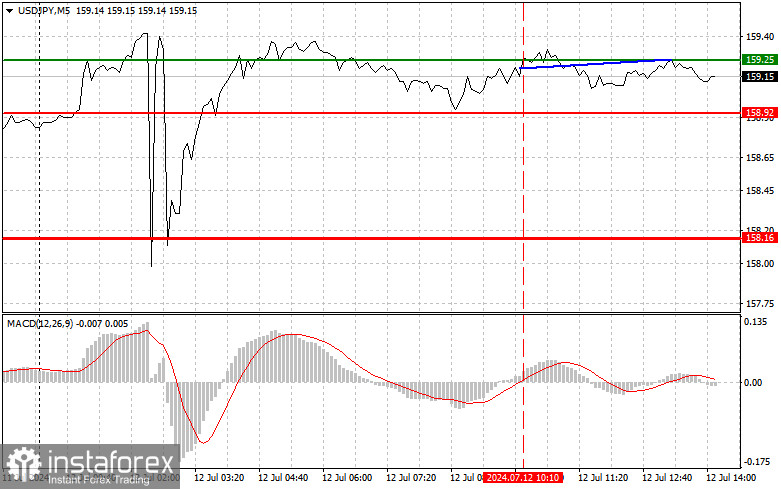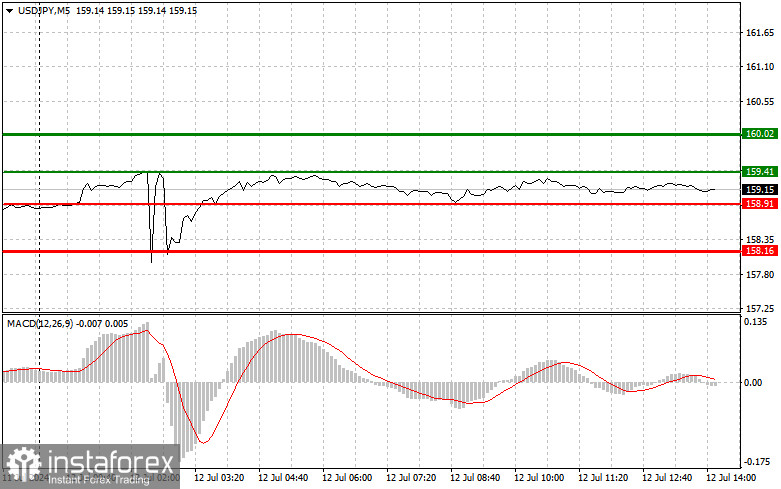Analysis of Trades and Trading Tips for the Japanese Yen
The test of the price at 159.25 occurred when the MACD indicator was just starting to move up from the zero mark, confirming the scenario for buying the dollar. However, as you can see on the chart, there was no significant upward movement. There were simply no buyers for the dollar after yesterday's significant sell-off, even at such attractive prices. During the American session, we expect data on the US Producer Price Index and the Producer Price Index excluding food and energy, as well as reports on the University of Michigan Consumer Sentiment Index and inflation expectations. Weak data indicating a decline in inflation will provoke new dollar sales and yen purchases, further increasing pressure on the pair. As for the intraday strategy, I plan to act based on the implementation of scenarios #1 and #2 to continue the trend.
Buy Signal
Scenario #1: Today, I plan to buy USD/JPY upon reaching the entry point around 159.41 (the green line on the chart) with the target of rising to the level of 160.02 (the thicker green line on the chart). At the 160.02 point, I will exit the purchases and open sales in the opposite direction (expecting a movement of 30-35 points in the opposite direction from the level). You can count on the pair rising today, but only after very strong data from the US. Important! Before buying, make sure the MACD indicator is above the zero mark and just starting to rise from it.
Scenario #2: I also plan to buy USD/JPY today in case of two consecutive tests of the price at 158.91 when the MACD indicator is in the oversold area. This will limit the pair's downside potential and lead to a market reversal upward. Growth can be expected to the opposite levels of 159.41 and 160.02.
Sell Signal
Scenario #1: I plan to sell USD/JPY today after updating the level of 158.91 (the red line on the chart), which will lead to a quick decline of the pair. The key target for sellers will be the level of 158.16, where I will exit the sales and immediately open buys in the opposite direction (expecting a movement of 20-25 points in the opposite direction from the level). Pressure on the pair will return in the event of a failed attempt to rise above the daily high. Important! Before selling, make sure the MACD indicator is below the zero mark and just starting to decline from it.
Scenario #2: I also plan to sell USD/JPY today in case of two consecutive tests of the price at 159.41 when the MACD indicator is in the overbought area. This will limit the pair's upward potential and lead to a market reversal downward. Decline can be expected to the opposite levels of 158.91 and 158.16.

What's on the chart:
- Thin green line: Entry price to buy the trading instrument.
- Thick green line: Expected price for placing Take Profit or manually fixing profits, as further growth above this level is unlikely.
- Thin red line: Entry price to sell the trading instrument.
- Thick red line: Expected price for placing Take Profit or manually fixing profits, as further decline below this level is unlikely.
- MACD Indicator: When entering the market, it's important to be guided by overbought and oversold zones.
Important: Beginner traders in the forex market need to be very cautious when making entry decisions. Before the release of important fundamental reports, it's best to stay out of the market to avoid sharp exchange rate fluctuations. If you decide to trade during news releases, always set stop-loss orders to minimize losses. Without setting stop-loss orders, you can quickly lose your entire deposit, especially if you don't use money management and trade large volumes.
Remember, for successful trading, you need a clear trading plan, like the one presented above. Making spontaneous trading decisions based on the current market situation is inherently a losing strategy for an intraday trader.





















